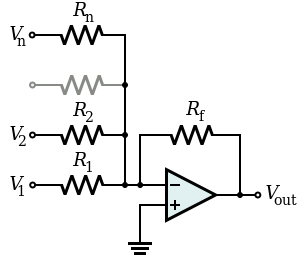Analogue communications
-
General amplifier systems
- Amplifiers increase the power of signals
-
A typical amplifier system has the following subsystems:
- A signal source, such as a microphone
- A preamplifier, such as a voltage amplifier, to increase the amplitude of the signal voltage, as well as the signal-to-noise ratio
- A mixer, to combine the signal from several sources
- A power amplifier, that amplifies the voltage, but more notable the current
- A signal output, such as a loudspeaker
- The gain of a voltage amplifier is G = VOUTVIN
- If the input signal goes so high that the output signal would go above the supply voltage, the output signal is clipped at the supply voltage
- Amplifiers contain components that respond differently at different frequencies, so the gain goes down at higher frequencies
- The bandwidth of an amplifier is the frequency at which the voltage gain falls to 70% of the maximum gain1
- The higher the voltage gain, the lower the bandwidth: gain⋅bandwidth = constant
- Multiple-stage voltage amplifiers are used when both high gain & bandwidth are needed
-
Operational amplifiers
-
Non-inverting amplifier
-
Circuit diagram:

- The gain is G = 1 + RFR1
-
Circuit diagram:
-
Inverting amplifier
-
Circuit diagram:

- The gain is G = -RFRIN
-
Circuit diagram:
-
Summing amplifier
-
Circuit diagram for an op-amp summing amplifier:

- The gain is G = -Rf∙nΣi=0ViRi
-
Circuit diagram for an op-amp summing amplifier:
-
- The bandwidth is more accurately the point at which the power gain falls to half the maximum gain, which is where voltage gain falls to 1√2 ↩